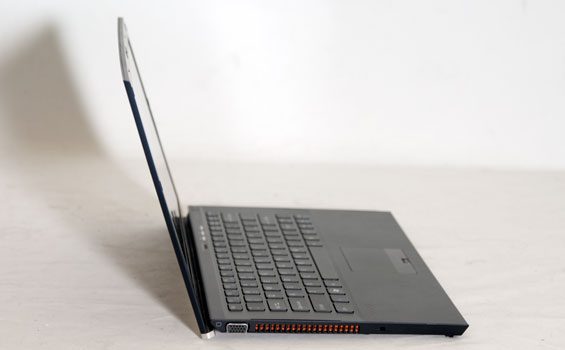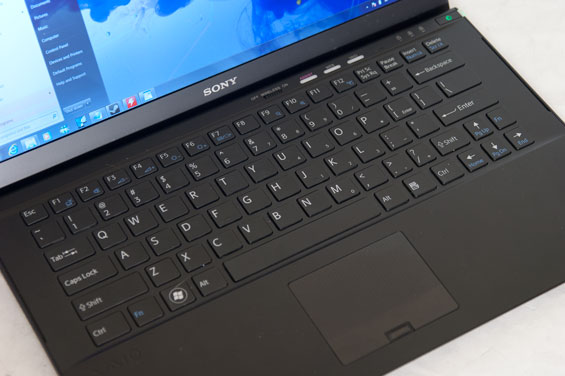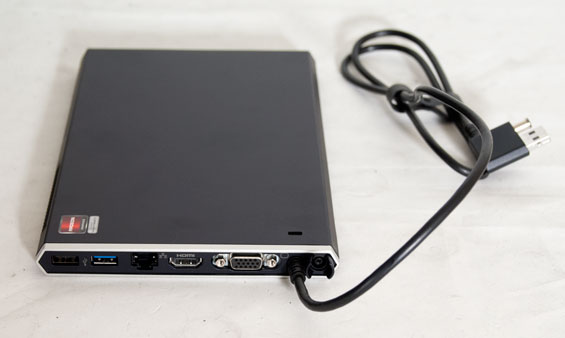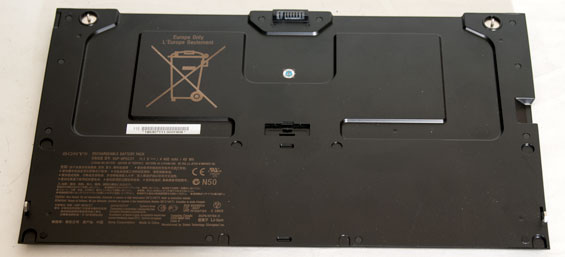Sony Vaio Z2: Everything is Peripheral
by Dustin Sklavos on February 13, 2012 12:55 AM ESTAccessories to a Crime
On paper, the Sony VAIO Z2 is an amazing ultraportable and promises just about everything a mobile professional could possibly want. It's less than three pounds, but get it hooked up to the wall with the docking station and suddenly it's a full featured notebook complete with DVD burner and dedicated graphics performance. Unfortunately, in many ways the Z2 fails to live up to its real potential.
The external design of the Z2 is attractive, as Sony employs a black carbon fiber shell over an aluminum frame for the notebook with glossy plastic used only for the VAIO logo on the lid. You can order it in gold or silver, but the matte black is beautiful enough on its own. There's also a silver accent along the hinge, and the inside and bottom of the notebook retain that sleek black carbon fiber design. This is a uniform, solid-looking notebook, and I have a hard time believing anyone will complain too much about it aesthetically.

So what's wrong with the shell design? It's utterly impractical. We'll start with the hinge, a design decision so atrocious I can't believe it actually made it to production. If you don't have the battery slice installed, the back of the hinge actually lifts the notebook off of whatever surface it's on, producing an incline for the keyboard. This is exactly the intended functionality, but the problem is that the only feet that provide any traction are the front two, causing the notebook to potentially slide during use. More than that, tilting the screen changes the entire incline of the notebook, making it that much harder to find a sweet spot for both typing and visual comfort. Using the battery slice alleviates this problem, but it's insane that you'd have to buy a $150 accessory just to improve ergonomics that should've been correct from the get go.

The Z2's problems don't really stop there, either. While keyboards are often a matter of some contention amongst you, the readership, the Z2's keyboard is a poster child for why so many people revile chiclet-style keyboards. Many of you don't have problems adjusting to notebook keyboards since there's so much variation between vendors, but this keyboard may very well put some of you over the edge. I have tiny, spidery fingers, and I couldn't keep from fat-fingering the keyboard. Depth and travel for the keyboard is horrendous, and key action is incredibly mushy.
The touchpad should fare better: it's dedicated as opposed to being a part of the rest of the shell, and has a fingerprint reader tucked away at the bottom. Unfortunately it's also smaller than you might like, and the touchpad and buttons are one piece of plastic instead of having a pair of dedicated mouse buttons. There isn't even a rocker switch, it's all just one piece. Once again, style over practicality.

Where the Z2 should redeem itself is the dock. While connectivity of the notebook on its own is quite good, the dock is undoubtedly where the action is. For what it's worth, Sony's Power Media Dock is a fantastic idea: it plugs into the AC adapter port and USB 3.0/dock port (it's not strictly USB 3.0, so don't try to use it with another notebook—it actually uses Intel's Light Peak technology for connectivity), and there's a pass-through for plugging in the AC adapter. Once it's hooked up, the Z2 detects it and asks you if you want the Radeon to power the interior screen or external monitors. This should be the feature that makes the Z2 alongside the stunning 1080p screen. Except there are major drawbacks.
The AMD Radeon HD 6650M inside the dock is limited to a PCI Express 2.1 x4 link instead of x8 or x16, and the performance hit is a noticeable one. Worse still, the only drivers you're going to find for the Radeon are on Sony's site: they don't use the publicly available drivers on AMD's site. You could argue that there's some secret sauce going on here, but the VAIO is using AMD's XGP standard, and either way you have yet another front where the 6650M is being hamstrung. I had to reboot the Z2 the first time I plugged the dock in just to get it to properly accelerate the internal monitor, and after that I still ran into the occasional problem during game testing; DiRT 3, for example, would only run windowed, and would only run on the Intel IGP.
Is the dock still better than nothing at all? Abso-freakin'-lutely. The 6650M is still a major upgrade on the Sandy Bridge IGP, and the added functionality (including the slimline optical drive) is appreciated. Unfortunately you're at Sony's mercy for driver updates, and we all know how reliable notebook manufacturers are at keeping video drivers current. We could also say that as long as you're going external, something a bit more potent than the 6650M would have been welcome; a 6770M would have boosted the clocks another 20%, and making the dock slightly bulkier shouldn't be too much of a problem.

Finally, there's the battery slice. Unlike the slice included with the VAIO S series we reviewed recently, this one actually requires you to screw the battery in to the bottom of the notebook. You rotate the outside edges with your thumbs and tighten the hold at the top. This seems like a sound idea, except the slice doesn't actually feel any more secure than the old latch-style locking system did. It's just a bit of added hassle. Thankfully the slice improves the ergonomics of the Z2 substantially without adding too much to the weight; the Z2 was already under three pounds, and the slice puts it a touch under four. It's an acceptable compromise for what the slice brings to the table.
















88 Comments
View All Comments
JarredWalton - Monday, February 13, 2012 - link
I've been trying to include metric on all my laptop specs for a while, but I guess I didn't pass the message along to Dustin. Consider him flogged for being an Imperialist scum. ;-)Solandri - Monday, February 13, 2012 - link
The point isn't that you can do the conversion yourself on a free web site. The point is that if the article author does the conversion once, then tens of thousands of readers don't have to do the same conversion themselves. 60 seconds saved * 50,000 readers = 1 month of aggregate time saved.Zoomer - Tuesday, February 14, 2012 - link
Metric is a SI standard. Imperial units aren't. Too bad.Sea Shadow - Monday, February 13, 2012 - link
I can't help but feel like this article was lost in time somewhere as a lot of things just don't add up.Correct me if I am wrong, but I could have sworn that the last Z to have the optical drive was 2 generations ago, that or at least it was 2 years ago. The Z sold last year didn't have an optical drive and was nearly identical in body styling.
Also the current Z doesn't ship with a 2620M, as the option was replaced by the 2640M a while back.
The gripe with the 4x PCI-E link seems trivial as that is all that Light Peak can support... Last I checked, the interface currently supports 10 Gbit/s. So what else is Sony supposed to do?
Not that it matters much, as people have been using their express card slot to make their own E-GPUs for quite some time now. I have a Lenovo x220t with an E-GPU and I can confirm that even a 1x link is enough for even BF3. Others have performed scaling tests and found that while there is a marked difference between 1x and 2x, anything above that has a minimal impact. So even a 4x link is plenty sufficient.
For information on E-GPUs check out this page: (NOTICE:You are responsible for your equipment)
http://forum.notebookreview.com/gaming-software-gr...
Also there is a typo on the first page:
1st page processor model is listed as " Core i7 2720M" but everywhere else it is listed as 2620M
I won't hold the typo against you, but this review feels out of date, and in my opinion does not meet the usual standards of an Anandtech review.
Rick83 - Monday, February 13, 2012 - link
Also, it would have been interesting to see if performance of the graphics card changes when using an external screen, attached directly to the dock.That way the framebuffer won't have to be flushed back (via the displayport segment of LP/TB? or PCIe?) to the laptop, and more bandwidth would be free on the link to the dock. If there truly was a bandwidth limit (at v2x4 and mid-end mobile graphics, there shouldn't be) it might have less impact in that case.
In the end, for me the SSD-RAID kills the deal. A single SATA 3 high-end SSD would have been plenty of fast enough, and would have instead allowed to either beef up cooling, allow swappable RAM, or just lower the price. Unless they are using a highly specific daughterboard for the SSD to save on space, there really is no reason in this day and age to stick two cheap SSDs where one good one would do the trick.
DoctorG - Monday, February 13, 2012 - link
If I remember correctly, LP is bi-directional, and most graphics card bandwidth is used to send data to the card, so sending back the framebuffer doesn't impact the performance all that much. There is a noticeable performance difference between the internal vs. external screen though, which I think has to do with the graphics drivers and extra processing required to render something back to the internal display.And yes, the SSD "raid" isn't two drives in the normal sense of the word -- it's two controllers, but they are one unit, and designed to be extremely thin. Also, this laptop came out more than six months ago, when the current, high-end controllers did not have as good a track record as they do now . . . I don't know Sony's reason behind the decision or anything, but those are my best guesses.
JarredWalton - Monday, February 13, 2012 - link
I'll see if Dustin still has the Z2 and can check the performance using an external display. As for the out-of-date aspect, that's mostly a factor of Sony not having sent us a review unit until we met with them at CES. The Z2 we're reviewing here technically launched around July last year, so it is six months old -- though it's still on sale. Granted, the CPUs were refreshed to the 2640M, 2530M, etc. but the extra 100MHz speed bump hardly matters.Anyway, while the hardware is six months old, we have had a LOT of requests to review the VAIO Z series, so when we finally got a chance to do so we took it. Hopefully, we can get the Ivy Bridge version reviewed closer to launch -- and hopefully it will address a few of our concerns with this model.
As far as the PCIe bandwidth being limited by Light Peak, that's fine. It's not really Sony's fault that Light Peak can't carry more than an x4 link, but it is their fault for choosing to use the technology this way. It seems reasonable that the bandwidth isn't so much a problem for rendering on an external display, but for some reason it causes some performance degradation with the internal display. Whatever the cause, though, what's important is that we point out the level of performance you can expect in a reasonable use case, and here the Z2 GPU is only fast enough for our "Value" (~medium detail) settings.
jonyah - Monday, February 13, 2012 - link
Yep, you're wrong on the model. the VPC-Z1, was the previous model. Sony usually updates the Z around June. So it won't be long till the Z3 is out. This article is just late since the Z2 has been around since last June. The Z is usually the last model of Sony's notebook line to be updated because they actually do some real engineering to fit everything inside such a small frame.clarkn0va - Monday, February 13, 2012 - link
I thought ultrabooks were supposed to be small and beautiful. 2.5 lbs is decently light, but this thing looks thicker than my 3-year old Timeline. Leave it to Sony to bring a knife to a gun fight.jonyah - Monday, February 13, 2012 - link
That's because the pictures show it with the optional battery slice attached. Remove the slice and you have a nice thin notebook. Not as thin as an ultrabook but also not as slow as one (I'm still waiting for an ultrabook that has more than 4gb of memory).